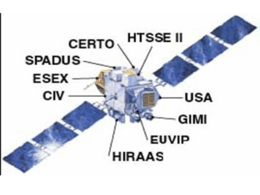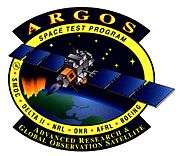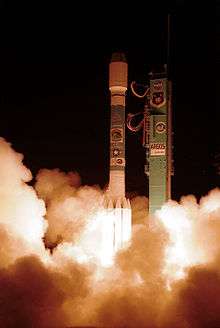ARGOS (satellite)
 Artist's rendition of ARGOS | |
| Mission type | Space environment |
|---|---|
| Operator |
AFRL NRL STP |
| COSPAR ID | 1999-008A |
| SATCAT № | 25634 |
| Mission duration | 3 years (planned) |
| Spacecraft properties | |
| Manufacturer | Boeing |
| Launch mass | 2,450 kilograms (5,400 lb) |
| Start of mission | |
| Launch date | February 23, 1999, 10:29:55 UTC |
| Rocket | Delta II 7920-10 |
| Launch site | Vandenberg SLC-2W |
| Contractor | Boeing |
| End of mission | |
| Last contact | 31 July 2003 |
| Orbital parameters | |
| Reference system | Geocentric |
| Regime | Sun-synchronous |
| Perigee | 828 kilometers (514 mi) |
| Apogee | 842 kilometers (523 mi) |
| Inclination | 98.78 degrees |
| Period | 101.47 minutes |
| Epoch | 5 December 2013, 06:21:33 UTC[1] |
 | |
The Advanced Research and Global Observation Satellite (ARGOS), not to be confused with the Argos System which employs Argos satellites, was launched on 23 Feb 1999 carrying nine payloads for research and development missions by nine separate researchers. The mission terminated on 31 July 2003.
ARGOS was launched from SLC-2W, Vandenberg AFB, CA, atop a Boeing Delta II (7920-10). Construction of the spacecraft bus and integration of the satellite's payloads was accomplished by Boeing at their Seal Beach, CA facility. The program was funded and led by the DoD's Space Test Program (STP) as mission P91-1 (the first STP mission contract awarded in 1991).
The $220M mission was operated by Air Force Space Command's Space and Missile Systems Center's Test and Evaluation Directorate (then Space Development and Test Wing, now SMC's Advanced Systems and Development Directorate)[2] from their RDT&E Support Complex (RSC) at Kirtland AFB, NM. ARGOS was the first mission operated 100% from the new state-of-the-art, commercial-off-the-shelf Kirtland facility; all previous SMC satellite missions had been operated in total or at least in part from the preceding center at Onizuka AFS, CA.
Mission
"The ARGOS satellite will provide a tremendous payoff in critical technologies such as imaging, satellite propulsion and space-based computing. These areas will become important as more and more applications of space are developed," said Colonel Tom Mead, program manager of the DoD Space Test Program.
The ARGOS had a design life of three years and was part of the DoD Space Test Program (STP), which supports the Air Force, Army, Navy, BMDO (now MDA), NASA, and various international space agencies. The nine ARGOS payloads, addressing more than 30 research objectives, conducted upper atmospheric observations and technology demonstrations. These included sensor technology for the International Space Station, as well as three high-priority ultraviolet imaging experiments and an X-ray sensor. The remaining experiments investigate ion propulsion, gas ionization physics, plume detection capabilities, and orbital debris. As part of DOD STP, ARGOS served the need to fly Department of Defense payloads that cannot be flown on the Space Shuttle or aboard small launch vehicles due to complexity, size, mission duration, or other constraints. The Naval Research Laboratory, U.S. Army Space and Strategic Defense Command, Air Force Research Laboratory, and Office of Naval Research have provided payloads for the ARGOS mission.[3]
Per the Kirtland AFB mission control center, "As of 1500 Zulu on 31 July 2003, support of all ARGOS operations has been terminated. Decaying inertial reference units has led to a tumble of the aircraft. As a result, communications with the spacecraft have been lost."
Payloads
"ARGOS will be the largest and most sophisticated research and development satellite Boeing has ever orbited for the Air Force," said Mr Will Hampton, Boeing director of U.S. Air Force Delta Programs.
Experiment (DOD Selective Experiments Review Board Year-Rank/Sponsor):
- CERTO - Coherent Electromagnetic Radio Tomography Experiment (1996-18/NRL) instrumentation, developed by NRL's Plasma Physics Division, consists of a stable radio beacon transmitter on the satellite and a chain of receivers on the ground. Radio transmissions from the CERTO beacon are processed by the ground receivers to produce two-dimensional maps of the electron densities in the ionosphere. The CERTO measurement technique provides images of the ionosphere with 10 km vertical and horizontal resolution. In addition, ionospheric irregularities of 1 km or less in size can be determined by fluctuations in the CERTO radio waves. CERTO can also be used to calibrate the ionospheric densities obtained using the EUV instruments such as HIRAAS, GIMI, and EUVIP on ARGOS. The CERTO radio-based technique has the advantage of higher spatial resolution than provided by the EUV-based techniques, but requires ground-based receivers aligned under the satellite orbit. The two techniques together on the same satellite provide substantial improvements over each technique separately. CERTO principal investigator, Dr. Paul Bernhardt notes that the NRL instruments on ARGOS will be the first demonstration combining EUV and radio sensors for enhanced imaging of the ionosphere.
- CIV - Critical Ionization Velocity Experiment (1990-9/AFRL-Kirtland AFB) Release of xenon and carbon dioxide gases from nozzles on the ARGOS orbiting with a velocity of about 7.4 km/s at an altitude of about 800 km is proposed. The releases will be conducted mostly in darkness over the Maui telescope site. The vector sum of the satellite and gas velocities will exceed the velocity requirement for the critical ionization velocity (CIV) process of xenon. It is feasible that the xenon gas will achieve critical velocity ionization. Associative ionization and collisional stripping will not occur for the xenon gas and there is no photo-ionization in darkness; ionization processes competing with CIV are absent. Neutral density, ambient magnetic field, and seed ionization effects on the xenon gas CIV will be discussed. Unlike xenon, carbon dioxide will not undergo CIV because of its higher velocity requirement. However, it is feasible that carbon dioxide colliding with the atmospheric species will form excited CO and OH molecules, which will radiate subsequently. Optical, IR, and UV observations on the satellite and at Maui Optical Telescope will provide diagnostic measurements for the experiment.[4]
- ESEX - Electric Propulsion Space Experiment (1990-13/AFRL-Edwards AFB): an effort by the Air Force Research Laboratory’s Propulsion Directorate (Edwards AFB, CA) demonstrated a high-powered electric propulsion provided by a 26 kilowatt ammonia fueled arcjet.[5] Its use in space and evaluate its performance and interactions with other experiments and spacecraft systems on board a satellite. Through the ionizing of ammonia, ESEX's electric propulsion was expected to double the payload-to-orbit capability of current space propulsion systems. The ammonia propellant consumed was four times less than the best performing chemical rocket engine in use at that time. For the team, the best information gathered was the validation that firing the highest powered electric propulsion system in space did not interrupt telemetry or affect other equipment on the spacecraft.[6]
- EUVIP - Extreme Ultraviolet Imaging Photometer Experiment (1990-8/Army Space & Strategic Defense Command) will establish the behavior of the upper atmosphere and plasmasphere needed for Army secure communication systems design, prediction of magnetic storms, and characterization of the aurora.[7]
- GIMI - Global Imaging Monitor of the Ionosphere Experiment (1990-19/NRL) will obtain wide-field FUV/EUV images of ionospheric and upper atmospheric emissions simultaneously, covering large areas of the earth from a low-earth orbit. These images will be used to determine chemical densities [O+, nighttime O2, NO and N2] on a global basis and to detect disturbances in the ionosphere that are caused by auroral activity, gravity waves and foreign materials from meteors, suspected "ice comets," rocket exhausts and chemical releases. In between the atmospheric observations, GIMI will also perform an all-sky survey of stars and celestial diffuse sources at far-ultraviolet wavelengths. The GIMI instrument has two coaligned cameras for simultaneous observations of selected targets. Camera 1, which is sensitive in the 75-110 nm range, will primarily be used for observations of the dayside ionosphere, auroras, and stellar occultations, and for star field surveys. Camera 2 is sensitive in the 131-160 and 131-200 nm far-UV wavelength ranges and will be used for observations of the nightside ionosphere, airglow, stellar occultations, star field surveys, and also gas releases and rocket plumes at night.

- HIRAAS - High Resolution Airglow/Aurora Spectrograph Experiment (1990-5/NRL) is a multi-instrument experiment that will scan the edge of the Earth's atmosphere (called the limb) about every 90 seconds to measure naturally-occurring airglow missions in the 50 to 340 nanometer (nm) wavelength range over a wide array of geophysical conditions and at varying local times. The instruments will perform continuous observations over several spectral bands with resolution up to ten times better than with previous experiments. These measurements will be used to infer the composition (O+, N2, O, and O2) and temperature. Data from the HIRAAS experiment will be used to explore new concepts in monitoring space weather from satellites, and to improve high frequency communications and over-the-horizon radar, which rely on propagation through the atmosphere. The measurements will also help researchers assess the long-term effects of the increases of atmospheric greenhouse gases on the upper atmosphere and ionosphere.
- HTSSE II - High Temperature Superconductivity Space Experiment (1992-2/NRL): developed by the Naval Research Laboratory will space qualify superconducting digital subsystems that could offer factors of 100 to 1000 in power reduction - more than ten times higher speed and similar weight reduction, than today's silicon or gallium arsenide (GaAs) based electronics. Spacecraft designers will evaluate the benefits for future systems.
- SPADUS - Space Dust Experiment (1990-33/Office of Naval Research) sponsored by the University of Chicago with funding by the Office of Naval Research, will measure velocity and impact of dust in space orbit.
- USA - Unconventional Stellar Aspect (1990-22/NRL) - Sponsored by Naval Research Lab, Space Science Division, the USA experiment was designed to observe bright x-ray sources, mostly binary star systems, including a black hole, a neutron star, or a white dwarf, orbiting with a more typical star. In neutron stars, gravity has compressed matter down to densities larger than those found in the nucleus of an atom. In all of these types of binary systems, extraordinarily strong, relativistic gravitational forces and enormous magnetic fields act in concert to produce dramatic phenomena not observable from Earth-based laboratories. In addition to providing valuable new information for astrophysicists and particle physicists, USA has been designed to make significant contributions to applied science, environmental science, and engineering research. It will use x-ray sources to test new approaches to satellite navigation and to conduct the first tomographic survey of Earth's atmosphere. It will also test new concepts for making spacecraft computers more reliable, an approach called fault-tolerant computing. Finally, a unique feature of USA is that photon events are time tagged by reference to an onboard GPS receiver allowing precise absolute time and location determination. USA operated from May 1, 1999 through November 16, 2000.
Bus characteristics
P91-1 ARGOS,[8] Ørsted (satellite)(SSC #25635) and SUNSAT (satellite; SSC #25636) Mission Book
- ARGOS Spacecraft mass: 5,491 lb (2,491 kg)
- The ARGOS satellite could generate 2200 watts of electrical power from solar panels
- Data Rates for SV: 4 & 128 kbit/s; Experiments: 1.024, 4.096, & 5 Mbit/s
- NASA sponsored the secondary payloads of Ørsted (satellite)[9] and SUNSAT,[10] were the first satellites of their respective countries, Denmark and South Africa.
Orbit characteristics
- Initial: Circular orbit altitude: 455 nmi (851 km), with inclination: 98.725 deg
- Final, post second-stage depletion burn: 335 x 459 nautical miles (833 km) orbit inclined at 96.7 degrees.
- Through the ESEX and CIV experiment operations, the mission orbit was lowered over two kilometers.
Liftoff postponements
After about six weeks stacked on the launch pad, and as long for mission crews to report only to replan activities for another night and slightly different time, the rocket and its satellites blasted away from Earth's pull.[11]
- 15 Jan 1999 - postponed launch 24 hours to complete testing of the link between the spacecraft and the ground telemetry station. "The spacecraft team observed noise intrusion on the telemetry signal sent from the spacecraft to the ground station. The spacecraft team has corrected the problem and validation testing is underway. The 24-hour delay allows the spacecraft team to finalize its testing prior to the launch vehicle upper stage fueling."[12][13][14]
- 21 Jan 1999 - launch postponed due to weather (upper level winds)[15][16]
- 22 Jan 1999 - launch postponed due to weather (upper level winds)[17]
- 27 Jan 1999 - launch postponed due to weather (upper level winds)[18]
- 28 Jan 1999 - launch postponed—the Boeing launch team determined that a propellant valve on vernier engine number two failed to open on command. This caused the engine shutdown and initiation of the autosafe mechanism on the launch vehicle. During the engine start sequence, the two vernier engines are required to ignite prior to ignition of the main engine. The main engine and two vernier engines were automatically shut down at approximately T-0 when it was detected that one of the vernier engines had failed to ignite. All vehicle safing systems performed as designed and expected.[19][20][21]
- 07 Feb 1999 - launch postponed due to weather (upper level winds)[22]
- 08 Feb 1999 - launch postponed due to weather (upper level winds)
- 12 Feb 1999 - launch postponed due to weather (upper level winds)[23]
- 13 Feb 1999 - launch postponed due to an electrical problem in the first stage of the booster[24]
- 21 Feb 1999 - launch postponed due to weather (upper level winds)[25]
- 23 Feb 1999 - the rocket lifted off at 02:29 PST from California's Vandenberg AFB.[26]
See also
References
- ↑ Peat, Chris (5 December 2013). "ARGOS - Orbit". Heavens Above. Retrieved 6 December 2013.
- ↑ "SMC stands up new Advanced Systems and Development Directorate", 24 November 2014
- ↑ Turner, J. B., Agardy, F. J., “The Advanced Research and Global Observation Satellite Program (ARGOS),” Space Programs and Technologies Conference, Huntsville, AL, Sept 27-29, 1994, AIAA-1994-4580.
- ↑ Lai, S., Häggström, I., Wannberg, G., Westman, A., Cooke, D., Wright, L., Groves, K., and Pellinen-Wannberg, A., “A Critical Ionization Velocity Experiment on the ARGOS Satellite,” 45th AIAA Aerospace Sciences Meeting and Exhibit, Reno, Nevada, Jan. 8-11, 2007, AIAA-2007-279.
- ↑ Press Release USAF, "NEW SPACE PROPULSION SYSTEM FIRED," March 17, 1999. Archived November 15, 2007, at the Wayback Machine.
- ↑ Sutton, A.M., Bromaghim, D R., Johnson, L K. “Electric Propulsion Space Experiment (ESEX) Flight Qualification and Operations,” Joint Propulsion Conference and Exhibit, 31st, San Diego, CA, July 10–12, 1995, AIAA-1995-2503.
- ↑ NSSDC Master Catalog Search, NSSDC ID: 1999-008A-02
- ↑ ARGOS Satellite Serves as Platform for Leading-Edge Technology and Research, 1999.
- ↑ NSSDC Master Catalog Search, NSSDC/COSPAR ID: 1999-008B
- ↑ NSSDC Master Catalog Search, NSSDC/COSPAR ID: 1999-008C
- ↑ D. Seitz, Operations Lead, RDT&E Support Complex
- ↑ Boeing News Release: Delta II Launch of ARGOS Satellite Scrubbed, 15 January 1999.
- ↑ Boeing News Release: Launch of ARGOS Spacecraft Postponed, 18 January 1999.
- ↑ Boeing News Release: Delta II Launch of ARGOS Satellite Rescheduled for Wednesday, 19 January 1999.
- ↑ Boeing News Release: Delta II Launch of ARGOS Satellite Postponed, 20 January 1999.
- ↑ Boeing News Release: Weather Postpones Delta II Launch of ARGOS Satellite, 21 Jan 1999.
- ↑ Boeing News Release: Upper Level Winds Postpone Delta II Launch of ARGOS Satellite, 22 January 1999.
- ↑ Boeing News Release: Upper Level Winds Postpone Delta II Launch of ARGOS Satellite, 27 January 1999.
- ↑ Delta II Launch Stopped Due to Engine Ignition Failure, 28 January 1999.
- ↑ Boeing News Release: Next Delta II Launch Attempt of ARGOS Scheduled for Sunday, 4 February 1999.
- ↑ Team Memory: Frank and Earnest panel #70170 ran days after this attempt. We contacted the publisher and asked if they heard of our launch attempt; they said no, they just thought the word usage was funny. The Kirtland AFB team purchased a copy of the panel with name ARGOS replacing NASA and gave them as momentoes to the Kirtland AFB launch and early orbit team
- ↑ Boeing News Release: Delta II Launch of ARGOS Satellite Delayed, 7 February 1999.
- ↑ Boeing News Release: Winds Postpone Delta II Launch of ARGOS Satellite, 12 February 1999.
- ↑ Boeing News Release: Delta II Launch of ARGOS Satellite Delayed, 13 February 1999.
- ↑ Boeing News Release: Delta II Launch of ARGOS Satellite Scheduled for Tuesday, 19 February 1999.
- ↑ Boeing News Release: Boeing Delta II Boosts Triple Satellite Payload, 23 February 1999.
External links
- slac.stanford.edu
- xweb.nrl.navy.mil
- pr.afrl.af.mil
- aero.org
- cnn.com
- nrl.navy.mil
- adsabs.harvard.edu
- air-and-space.com
- "Fact Sheet : USAF SMC's Space Development and Test Wing".
- nssdc.gsfc.nasa.gov
- space.skyrocket.de
- space.skyrocket.de